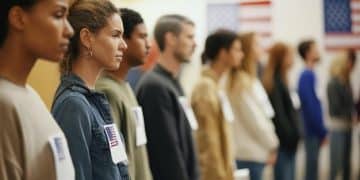Examining the Impact of Legislation on Social Justice Movements

Examining the impact of the proposed legislation on social justice movements offers a crucial analysis of how new laws can either advance or hinder the progress of equality, equity, and human rights in society.
Examining the impact of the proposed legislation on social justice movements: a critical analysis is vital to understanding how laws shape our society. This article explores the potential consequences of new laws on these movements.
Understanding the Framework of Social Justice Movements
Social justice movements are often grassroots efforts that arise in response to perceived inequalities or injustices within a society. The framework of these movements involves various elements that drive their actions and goals.
These movements typically advocate for policy changes, raise awareness about specific issues, and mobilize communities to demand reforms. Understanding their structure and goals is crucial for assessing the potential impact of proposed legislation.
Key Principles of Social Justice
Identifying the core values that underpin social justice movements helps in understanding their objectives and the potential implications of laws.
- Equality: Ensuring that every individual has equal rights, opportunities, and access to resources, regardless of their background.
- Equity: Recognizing that different people may require different levels of support to achieve equal outcomes.
- Human Rights: Upholding the fundamental rights and freedoms of all individuals, as outlined in international declarations and conventions.
- Inclusivity: Creating a society where everyone feels valued, respected, and able to participate fully.
Historical Context of Social Justice Movements in the US
Understanding the historical backdrop against which social justice movements have operated provides insights into their ongoing struggles and triumphs.
From the Civil Rights Movement to the women’s suffrage movement, the history of the United States is rich with examples of collective action aimed at achieving social justice. These movements have often faced significant legislative and political obstacles, shaping their strategies and goals.
Examining these historical precedents is essential to understanding the potential challenges and opportunities presented by new legislation.
In conclusion, understanding the framework of social justice movements requires an appreciation of their key principles and their place in history, offering a foundation for evaluating the effects of new legislation.
Analyzing Proposed Legislation: A Methodical Approach
Analyzing proposed legislation requires a methodical approach to dissect its content, understand its intent, and project its potential impacts.
Effective legislative analysis goes beyond surface-level reading, diving into the specifics of each clause to identify how it might affect various groups and movements.

Step-by-Step Legislative Analysis
A structured process can help ensure comprehensive assessment of proposed bills and laws.
- Textual Examination: Carefully read the text of the proposed legislation to identify key provisions, definitions, and requirements.
- Contextual Analysis: Understand the legislative history, including committee reports, debates, and amendments.
- Stakeholder Assessment: Identify individuals, groups, and organizations that may be affected by the legislation.
- Comparative Review: Compare the proposed legislation to existing laws and policies to understand its relationship to the current legal framework.
Potential Impacts on Social Justice Issues
It is critical to evaluate how the proposed legislation could impact specific social justice issues, such as racial equality, gender equality, LGBTQ+ rights, and environmental justice.
For example, consider whether the legislation promotes or hinders efforts to address systemic discrimination, protect vulnerable populations, or advance environmental sustainability.
This analysis should also consider the potential unintended consequences of the legislation on social justice movements.
In summary, a methodical approach to analyzing proposed legislation ensures a comprehensive understanding of its potential impact on social justice issues, helping advocates and policymakers make informed decisions.
The Role of Advocacy Groups and NGOs
Advocacy groups and NGOs (Non-Governmental Organizations) play significant roles in shaping public opinion and influencing policy decisions relating to social justice movements.
These organizations often serve as watchdogs, monitoring legislative developments and mobilizing communities to advocate for or against proposed legislation.
Strategies Used by Advocacy Groups
Advocacy groups employ diverse strategies to advance their causes and exert influence in the legislative process.
Lobbying is a direct and often effective way to approach legislators. Public awareness campaigns can shift general opinion, and legal challenges can test the constitutionality of the legislation.
Coalition Building also helps consolidate the resources and political capital of various groups.
Effective advocacy combines deep expertise, grassroots mobilization, and strategic communication to shape policy outcomes. Understanding these approaches is essential for appreciating their impact on social justice movements.
Case Studies: Successful Advocacy Campaigns
Examining past advocacy campaigns can shed light on the tactics that work and the challenges involved.
One common example is how coalitions successfully fought discriminatory laws in the Civil Rights era. Another example is successful campaigns to advance LGBTQ rights. These case studies reveal the importance of sustained efforts, strategic alliances, and effective storytelling.
By learning from these cases, advocacy groups can refine their approaches and increase their chances of success. These success stories offer valuable lessons for navigating the complexities of legislative advocacy.

In conclusion, advocacy groups and NGOs play essential roles in shaping legislative outcomes and advancing the goals of social justice movements through various strategies and tactics.
Assessing the Potential for Unintended Consequences
Legislation intended to advance social justice may sometimes produce unintended consequences, highlighting the need for careful consideration and foresight.
A thorough assessment of potential unintended effects is crucial for minimizing harm and maximizing positive outcomes. Laws can often have trickle-down effects that are not immediately apparent.
Examples of Unintended Consequences
It is important to consider various case studies of legislation that had unexpected outcomes, often because of hidden assumptions.
- Criminal Justice Reform: Some reforms intending to reduce incarceration rates may inadvertently lead to increased crime rates if not implemented carefully.
- Environmental Regulations: Regulations designed to protect the environment may disproportionately affect low-income communities if not implemented equitably.
- Affirmative Action Policies: Policies intended to promote diversity may lead to backlash and resentment if perceived as unfair.
Mitigating Negative Impacts
Strategies to mitigate unintended consequences involve thorough consultations, pilot programs, and evidence-based adjustments.
Consultations with diverse stakeholders can help identify potential problems early on. Pilot programs allow for testing proposed laws in a controlled setting. Evidence-based adjustments ensure that policies are continuously refined based on empirical data.
By adopting such strategies, policymakers can improve the chances of achieving their desired outcomes while minimizing unintended harm.
In summary, assessing and mitigating the potential for unintended consequences is crucial for effective policymaking, ensuring that legislation truly serves the interests of social justice.
Engaging Communities in the Legislative Process
Engaging communities directly in the legislative process is essential for ensuring that laws reflect their needs and priorities.
Community engagement promotes transparency, accountability, and inclusivity, leading to more equitable and effective policies. Ignoring the needs of communities can create laws that are perceived as irrelevant or even oppressive.
Methods for Community Engagement
Various methods can be deployed to effectively involve communities in the legislative process.
Town hall meetings allow for direct dialogue between policymakers and community members. Public hearings provide a platform for individuals to share their perspectives on proposed legislation. Online forums and social media create opportunities for virtual participation.
Community-based participatory research ensures that research efforts are driven by community needs and priorities.
These methods foster collaboration and mutual understanding, strengthening the legitimacy of the legislative process. Community engagement should be seen as an essential aspect of all policy decisions.
Overcoming Barriers to Participation
Efforts to maximize community engagement must address barriers that can limit participation, such as language barriers, lack of access to information, and mistrust of government.
Providing translation services, offering accessible formats for information, and building trust through outreach and education are essential steps. Addressing these barriers helps ensure that all community members have an equal opportunity to participate in the legislative process.
It also demonstrates a commitment to inclusivity and respect for diverse perspectives.
In conclusion, engaging communities in the legislative process is vital for creating laws that are responsive to their needs, equitable in their impact, and supported by those they affect.
The Long-Term Effects on Social Cohesion
Proposed legislation can have long-term effects on social cohesion, either reinforcing or undermining solidarity and trust within communities.
Laws that promote equity and inclusion can strengthen social bonds, while those that exacerbate inequalities can erode them. The cumulative effect of these policies has a lasting legacy.
Positive and Negative Outcomes
Assessing the potential long-term outcomes involves carefully examining both the positive and negative possibilities.
A more just and equitable society promotes trust, cooperation, and shared prosperity. Increases in inequality, discrimination, and social division weaken civil society and increase polarization. Policies that are poorly conceived or implemented can ripple outward to impact social cohesion.
Understanding these dynamics is essential for policymakers seeking to create a more cohesive and harmonious society. Social cohesion must be a chief concern when crafting laws.
Building Bridges Through Legislation
Legislation should aim to build bridges between different groups, promoting understanding, empathy, and mutual respect.
Policies that address systemic inequalities, promote inclusive education, and foster cross-cultural dialogue can help create a more unified and resilient society. These efforts require a long-term commitment to social justice and a willingness to challenge entrenched biases.
Success can contribute to a greater sense of belonging and shared purpose.
In summary, the long-term effects on social cohesion must be carefully considered when assessing the impact of proposed legislation, recognizing that laws can either strengthen or weaken the fabric of society.
| Key Point | Brief Description |
|---|---|
| ⚖️ Legislative Analysis | Methodical review to understand the intent and potential impacts of proposed laws. |
| 📢 Advocacy Groups | NGOs shaping policy to influence decisions. |
| 🚧 Unintended Consequences | Laws require careful assessment to mitigate risks and ensure positive outcomes. |
| 🤝 Community Engagement | Essential for laws to reflect needs, promoting transparency and accountability. |
FAQ
▼
A social justice movement is a collective effort by members of a community to advocate for equality and fairness. These movements address systemic injustices through policy change and awareness campaigns.
▼
Advocacy groups influence legislation through lobbying, public awareness campaigns, and legal challenges. They also focus on building coalitions to amplify their reach and impact on policymakers.
▼
Unintended consequences are unexpected outcomes of laws that can negatively affect certain groups or communities. These consequences often result from insufficient planning or oversight of policy decisions.
▼
Community engagement is critical because it ensures laws reflect the needs of those most affected. It fosters inclusivity, transparency, and leads to more effective and equitable policies.
▼
Laws can either strengthen or weaken social cohesion by promoting or undermining solidarity and trust. Legislation that encourages equity tends to fortify social bonds, while laws causing division undermine them.
Conclusion
Examining the impact of the proposed legislation on social justice movements: a critical analysis involves understanding complex interactions between policy, advocacy, and community engagement, therefore leading to better legislation.





